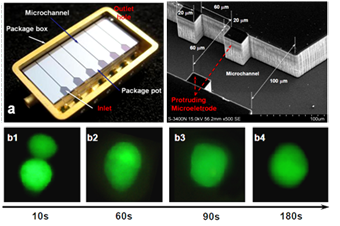Electrokinetics has emerged as one of the most promising techniques to manipulate fluid, particles and ions in micro/nano-fluidic devices, which have the potential of revolutionizing various bioanalytical applications.
The first half of this talk will be on experimental and numerical studies of electrokinetic particle transport in several types of microfluidic channels, with emphasis on dielectrophoretic (DEP) effect. The numerical predictions are in quantitative agreement with our own and other researchers’ experimental results. It has been found that the DEP effect could be utilized to separate, focus and trap particles in microfluidic devices. DEP particle-particle interactions could assemble and form particle chains parallel to the applied electric field, based on which a microfluidic device has been developed to achieve a high throughput cell electrofusion (Fig.1).
The second half of this talk will present numerical study of electrokinetic fluid, ion and particle transport in nanofluidics. A continuum-based numerical model, which is capable of dynamically tracking the particle translocation through a nanopore with the consideration of the finite electrical double layers adjacent to charged surfaces, has been developed. The predictions on the ionic current change due to the presence of particles inside the nanopore are in qualitative agreement with existing experimental results. Furthermore, various analytical models for ionic conductance and streaming conductance in pH-regulated nanofluidics have been developed and validated by experimental data available from the literature.

Fig.1. a high-throughput cell electrofusion microfluidic device.
钱诗智教授简介:
钱教授分别于1994年和1998年在华中科技大学取得本科学位和博士学位。随后在工业界担任高级工程师两年。 2001年2月至2002年8月在宾夕法尼亚大学任博士后研究员,并于 2002年9月至2004年12月在宾夕法尼亚大学获得第二个博士学位。后来晋升为研究助理,并在宾夕法尼亚大学工作直到2005年8月加入内华达拉斯维加斯大学担任助理教授。2008年7月,他加入欧道明大学航空航天工程系担任助理教授,并于2011年7月晋升为终身副教授。2009年至2014年期间,他任韩国WCU(世界一流大学)计划教授。自2002年以来,他已发表150多篇SCI期刊文章。
欢迎有兴趣的师生参加!
